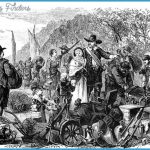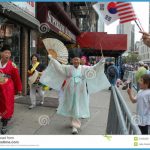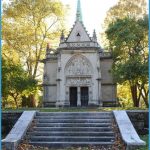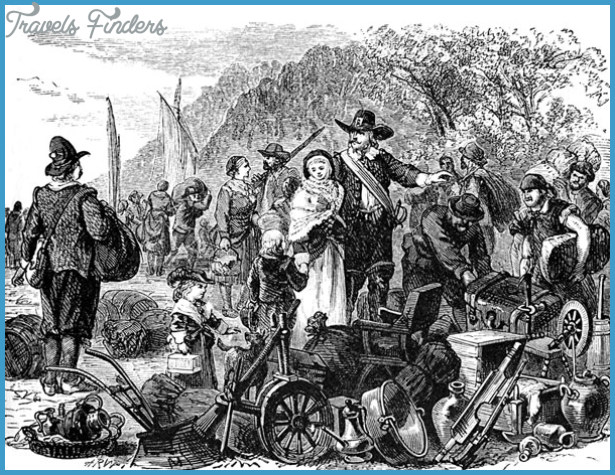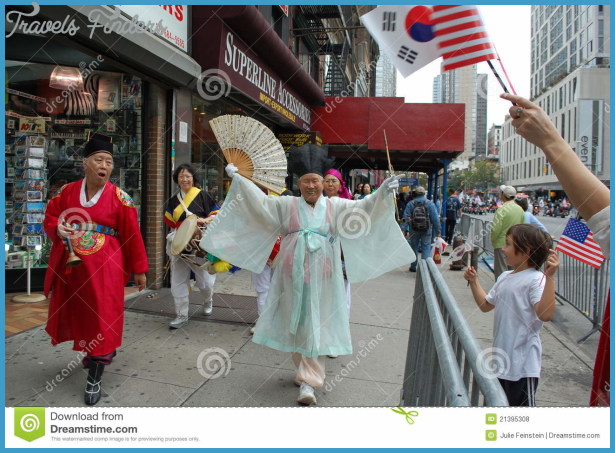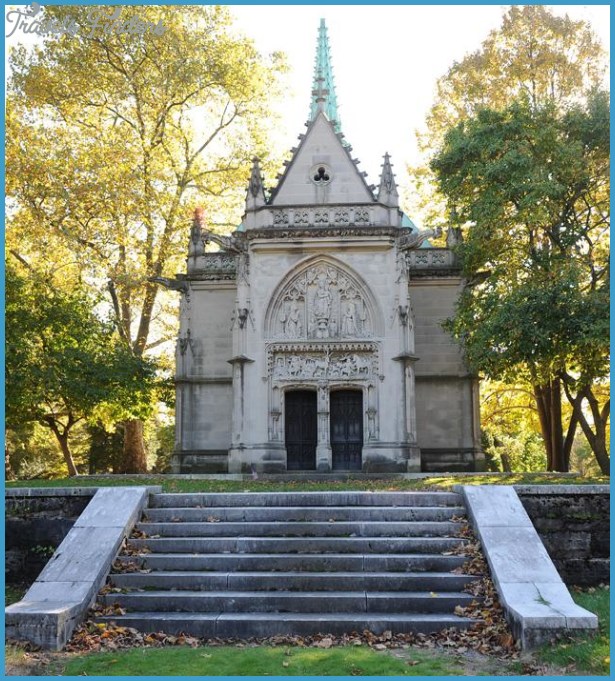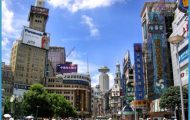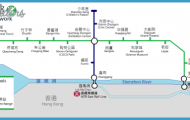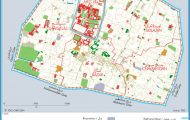The cultural contributions of New York Latinos span the whole spectrum of human creativity including the arts, culinary, sports, fashion, and religion. Carolina Herrera and Oscar De La Renta are two outstanding Latino names in haute couture. Hundreds of restaurants offer delicacies typical of the Latino nations represented in New York. However, with the exception of a few Cuban and Spanish places, Latino restaurants are patronized mostly by an ethnic clientele and do not reach the level of haute cuisine. There are in the city and suburbs numerous venues for the performing arts. The best known among them include Repertorio Espanol, Puerto Rican Traveling Theater, Thalia Theater, Teatro La Tea, and the Nuyorican Poets Cafe. Small and cozy, the Cafe reminds one of a local comedy club. Whether on weekdays or weekends, a visitor may expect to have to stand in line by the door. Poetry slams, and theater and musical performances in English, Spanish, and Spanglish express the creative energies of Puerto Ricans and other New Yorkers, reflecting traditional as well as futuristic visions.
Galleries and museums in the city exhibit and sell the works of plastic artists throughout the year. El Museo del Barrio has the distinction of being located within the so-called Museum Mile, along Fifth Avenue, where other prestigious museums are located including the Metropolitan Museum of Art and the Guggenheim. But it is probably in music and sports that Latinos have made longer and deeper strides within U.S. culture.
The closer links established between the United States and the Caribbean, especially with those nations that at the turn of the century fell under U.S. control such as Puerto Rico and Cuba coincided with the invention of the phonograph and the concomitant recording industry. Companies such as Columbia, Victor, and Edison had their recording studios in New York City, and they wanted to exploit the markets that were being created by U.S. might. To sell phonographs, and later radios, U.S. companies started recording local artists in Cuba, Puerto Rico, and Mexico. They sometimes took their recording equipment to those countries, but they also brought singers and players to their studios in New York City. When artists become part of the migration flow and stay as permanent residents of the city, recording companies draw from this local pool as
well. The growth of a Latino population in New York State created an additional market for ethnic music, which now could be sold locally and, at the same time, exported to all Spanish-speaking countries. The early 1920s, for instance, found in New York Puerto Rican musicians some gifted composers, including Rafael Hernandez and Pedro Flores. In addition to musical talents, some of them had a gift to promote themselves and others. Manuel Jimenez Canario, the first Puerto Rican singer to record music in New York, opened opportunities for many through his contacts with labels such as Pathe and Odeon.23 He launched la plena, a Puerto Rican rhythm born around 1900, to a commercial success, and on to a decade of popularity not only among Puerto Ricans in New York, but throughout the Spanish-speaking parts of the continent. Rafael Hernandez himself established Almacenes Hernandez, some of the first music stores in Manhattan, whereas his sister Victoria set up a recording venture, the Hispano label. Musical talent abounded among migrants who supplemented their incomes, and who entertained and helped their compatriots and other Latinos enliven an existence burdened with the stress of drudgery by playing in trios, cuartetos, and conjuntos in house parties or dancing halls.
Cuban musicians have been regulars in the New York scene since the mid-1930s, and they made contributions that will reach beyond the Latino audience for decades to come. The first names to make an impact were band leaders such as Xavier Cugat and Don Azpiazu, both of whom scored the first Spanish-language big success with El Manisero. The decade of the 1940s brought gifted musicians who in their diverse roles as composers, arrangers, and performers made epoch. For about two decades the spotlight fell on musicians such as Mario Bauza, Damaso Perez Prado, Alberto Socarras, Chano Pozo, Arsenio Rodriguez, and Mongo Santamarla, as well as on bands such as Machito y sus Afrocubans and La Sonora Matancera. These musicians and bands became inextricably embedded with the history of a musical age marked by rhythms such as rumba, mambo, and cha-cha. Desi Arnaz’s (Ricky Ricardo) career began in New York with Xavier Cugat, and it continued in Hollywood as he became the producer of I Love Lucy, the most popular TV comedy show in the 1950s and 1960s.
The merging of Afro-Cuban rhythms with African American blues and jazz, as well as the mingling of Latino musicians with African American players such as Dizzy Gillespie, produced lasting innovations whose effects are still felt in ballroom dancing and Latin Jazz. Other combinations of talents and rhythms led to the creation of new genres, such as salsa in the early 1970s, which produced a new generation of performers around the legendary Fania All Stars. Although the musicians were overwhelmingly Cuban and Puerto Rican such as Willy Colon, Tito Puente, Ray Barreto, the Palmieri brothers, Celia Cruz, and Hector Lavoe there were also representatives from Colombia, Venezuela, Panama, and the
Dominican Republic among whom were Johnny Pacheco and Ruben Blades and even Jewish Americans such as Larry Harlow. People all over the world are still dancing to the beat of Caribbean New York rhythms.
A new generation of Caribbean Latinos coming of age in the depths of the South Bronx have channeled their creative energies into hip-hop since the early 1970s. Mostly Puerto Rican, together with African American youths, they forged a new genre where their talents as MCs, DJs, rhyme-makers, and break-dancers shone. Hip-hop reached popularity in the last two decades of the twentieth century, and it catapulted to fame artists such as Big Pun and Fat Joe. During the 1980s merengue, a new dance rhythm, took hold of New York. This Dominican rhythm reached international audiences during the last two decades of the twentieth century. However, in the 1990s Juan Luis Guerra’s success made bachata rise to challenge merengue for the title of most popular Dominican rhythm.
In the realm of sports, Latinos have been making great contributions, particularly to America’s national pastime, baseball. During the first half of the twentieth century, when baseball was segregated, a few Cubans who could pass for whites were hired in professional mainstream baseball teams. However, the majority of Cubans played in the Negro league. But once the racial barrier was broken by Jackie Robinson in 1947, players from the Caribbean started to populate the major league. In the early 1950s the New York Giants signed Hall-of-Famer Orlando Cepeda, pitcher Ruben Gomez, and infielders Jose Pagan and Julio Gotay. The first Dominican recruited by a New York team was infielder Oswaldo Virgil, in 1956. It would take three decades for Dominicans to become the most prominent Latino group in American baseball. In the first decade of the twenty-first century Latinos represent about 30 percent of the players (close to 400) in the major league.
The Mets and the Yankees rely to a large extent on Latino players, and in their rosters appear some of the current luminaries: Pedro Martinez, Alex Rodriguez, Bernie Williams, Jorge Posada, Carlos Beltran, Orlando El Duque Hernandez, and Jose Reyes. In addition to enhancing the quality of the spectacle for American audiences and attracting Latinos to the stadiums, the talented Latino players represent a great source of profits for their teams and related businesses. A player such as Alex Rodriguez, who earns $23 million a year under his current contract, brings $47 million in revenues for the Yankees. Each game Rodriguez helps his team win means an additional $4.6 million for the Yankees, on account of increased tickets and merchandise sales, as well as higher prices for sponsorships and commercials.24 Moreover, thanks to the system devised by U.S. teams of establishing baseball academies in Latin America, player development became cheaper. The country that contributes the largest number of recruits is the Dominican Republic. In total, about 700 prospects are brought every year to the United States. From this pool, the most talented are offered the contracts that transform some underschooled and impoverished youngsters into members
of an exclusive club of millionaires. Those who do not make it end up struggling to survive in New York, like many other undocumented workers.
Churches and temples in New York City vibrate with religion Latino style. Revivalist practices have become characteristic of Latinos’ contribution to Catholic life in New York City. The Cursillo and Charismatic Renewal movements which began in 1960 and 1967, respectively are two prominent examples. Cursillistas are lay persons trained to be leaders of spiritual renewal in the parish and the community. For its part, the Charismatic Renewal has widespread appealing. The faithful hold services outside the regular mass schedule, typically on Tuesdays and Fridays. Under the direction of lay leaders, they study the Scripture and revel in singing and praising the Lord. A Charismatic Renewal meeting is an intense and emotional session with occasional speaking in tongues and spirit possession.
Emotive outpouring is something that Latino Catholics have in common with Protestants. It is no mere coincidence that most Latino Protestants are Pente-costals and evangelicals, for these religious orientations seem to fit best Latinos’ predisposition for intense expression. Charismatics, evangelicals, and Pente-costals are similar in intensity of participation (for example, in singing, praising, and possession), opportunities for the laity to lead religious activities, and reliance on the Bible for reference, guidance, and inspiration. Like Pentecostals, Charismatics also value healing sessions; they say they have witnessed the healing work of the Holy Spirit on the bodies and souls of participants as well as of people visited at home. The similarities stemming from common social class background and common cultural elements minimize the theological differences that may exist between Latino Catholics and Protestants for example, the centrality or not of the Virgin Mary.
That is to say, Latinos’ ways of feeling and expressing transcend the particular and temporary forms of religious affiliation, with some making their way back and forth from one organizational form to another. For example, some Catholics attend evangelical services on weekdays but mass on Sundays, and some evangelicals return eventually to the Catholic fold. In their search for material and spiritual well-being, Latinos patronize the ubiquitous botanicas. In these places they find spiritual advisors and ingredients to prepare house remedies and potions as well as objects used in Santeria, Voodoo, and other non-Christian practices.
Churches in Latino areas serve as places for cultural affirmation: the Spanish language is used, music is performed (featuring choirs, but also guitars, guiros, and congas) and traditional rituals are reenacted. Here Latinos of various national ancestries recognize each other, and they pass on common values to the younger-generation Latinos, who learn to share under the same church’s roof with other Latinos. With great anticipation, laity and clergy work throughout the year in preparation of events such as the Feast of Our Lady of Altagracia, Mother’s
Day, Feast of St. John the Baptist, Feast of Our Lady of Charity, and the Feast of Virgin of Guadalupe, which constitute rallying events in New York parishes with Latino communities. These celebrations bring together not only Latinos from different origins but also the Catholic churches in countries south of the border, for pilgrim priests and bishops tour New York areas of Latino settlement, saying mass and staging vigils with sacred images and statues carried from Latin America. By sharing patron saints and taking turns in the schedule of celebrations, congregants in these neighborhoods come together and discover that despite the diversity in their midst, Latinos share transcendental symbols for example, the Eucharist, the cross, Jesus’ mother as well as general sociocultural characteristics and concerns that unify them.
notes
1. Julie Salamon, Celebrating Mexican Life in New York, New York Times, December 8, 2004, 1, http://www.nytimes.com/2004/12/08/arts/08mexc.html.
2. Fine, 2005, 164, http://pas.sagepub.com/cgi/content/abstract/33/1/153.
3. Sanchez-Korrol, 1994, 12.
4. Anton and Hernandez, 2002, 51.
5. Sanchez-Korrol, 1994, 23, 33.
6. Police Department, City of New York, http://www.nyc.gov/html/nypd/pdf/chfdept/ cs023pct.pdf.
7. Sanchez-Korrol, 1994, 142.
8. Andres Torres, Between Melting Pot and Mosaic (Philadelphia, PA: Temple University Press, 1995), 87.
9. U.S. Census Bureau, http://www.census.gov/prod/ec02/sb0200cshisp.pdf.
10. Jaker et al. 1998, 33.
11. Rodriguez De Leon, 1998, 52.
12. Torres-Saillant and Hernandez, 1998, 35.
13. Torres-Saillant and Hernandez, 1998, 79.
14. Salvatierra, Latino Data Project, 2.
15. Sanchez-Korrol, 1994, 189.
16. Andres Torres, Between Melting Pot and Mosaic (Philadelphia, PA: Temple University Press, 1995), 79.
17. Badillo, One Nation, One Standard, 2006, 57.
18. Bergad, Latino Data Project, 3.
19. Kosmin and Keysar, 1992, 10.
20. Alessandro Rampietti, Finding God in a New Land: Hispanic Immigrants Turning to Evangelical Churches, Columbia Journalist, December 12, 2005, http://www. columbiajournalist.org.
21. Maria Benita Vasquez, Ministerio Way Out: en 37 anos hemos ayudado alrededor de 8 mil adictos a las drogas y el alcohol, Prensa Cristiana New York, March 2007, 4.
22. Cruz et al. Latino Voting in the 2004 Election.
23. Glasser, 1997, 178.
24. Danielle Sessa, Rodriguez is Bargain for Yankees at $23 Million, Economist Says,
http://www.bloomberg.com/apps/news?pid=20601103&sid=aAXWEnG1R6I0&refer=us.

